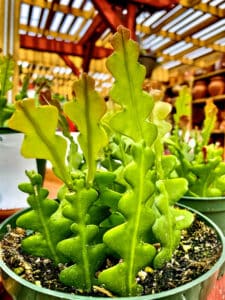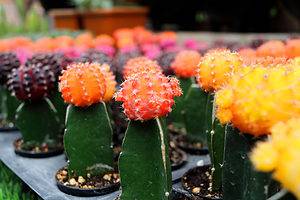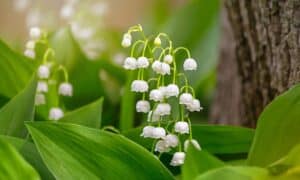Japanese maple trees are renowned across the world for their beauty. In the fall months, these trees and shrubs develop lovely colors on their leaves, including red, bronze, purple, and yellow. Because of this, they are a lovely addition to any garden, park, or home. But did you know they can also be grown as Bonsai trees?
In fact, Japanese maple trees are a very popular choice for Bonsai tree art. It’s easy to see why; they are small, beautiful plants that are generally easy to grow and style. Read on to discover everything you need to know about Japanese maple Bonsai trees!
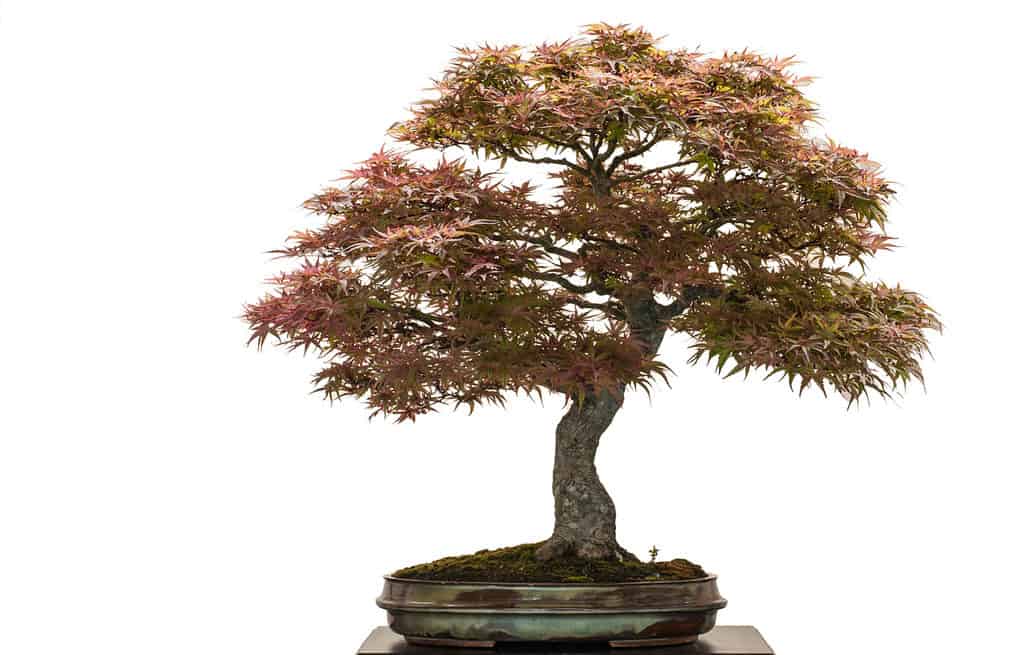
Japanese maple trees make perfect Bonsai trees!
©Bernd Schmidt/Shutterstock.com
| Japanese Maple Bonsai Tree Information | |
|---|---|
| Botanical Name | Acer palmatum |
| Common Types | Coonara Pygmy, Crimson Queen, Red Dragon, Full Moon, Butterfly, First Ghost, Geisa Gone Wild, Koto Ito Komachi |
| Sunlight | Full sun to partial shade, depending on the variety. Indirect sunlight protects their leaves. |
| Soil | Moist and well-draining. Bonsai tree soil mixtures should suit these trees well! |
| Water | During the growing season, make sure to water daily. |
| For Beginners? | Yes. While easy to care for and style, sometimes they may need extra care and attention. |
| Indoors or Outdoors? | Outdoors |
| Pairs Well With… | Moss, rocks, and other natural ornamentation |
Common Types of Japanese Maple Bonsai Trees
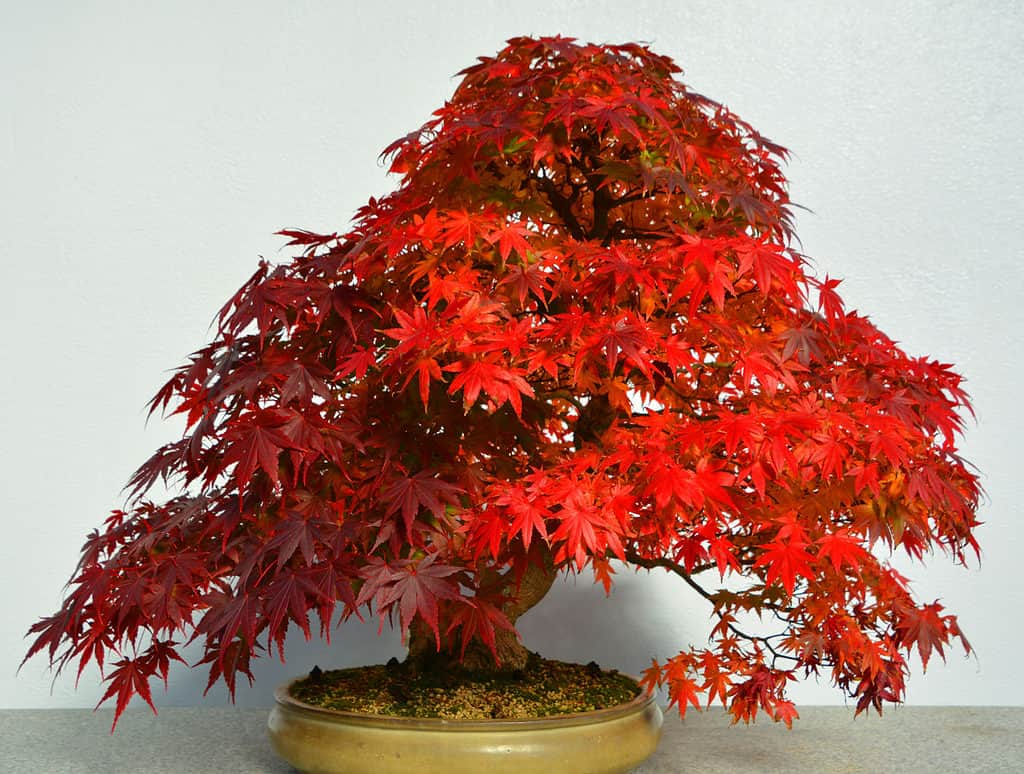
Changing colors in the fall, Japanese maple Bonsai trees always display beautiful foliage.
©meunierd/Shutterstock.com
Japanese maple trees are native to Japan, Korea, and China. They can also be found in parts of Russia and Mongolia. These trees are known for their small stature, as most of them do not exceed heights of 35 feet! Because of their size and beauty, these trees can be found in Japanese gardens across the world. They are also very popular for gardens at home!
There are many different types and cultivars of Japanese maple trees, including dwarf varieties. These varieties make wonderful, colorful Bonsai trees but other types of Japanese maple trees can also be grown as Bonsai trees. Here are some of the most common types of Japanese Maple Bonsai Trees!
Coonara Pygmy
In the spring, the leaves of the Coonara pygmy are a bright green color. During the summer, they gain shades of yellow. Finally, during the fall, the leaves turn the vivid red color that maple trees are known for.
Coonara pygmy trees are slow growing and, when planted naturally, reach a height of only 6 to 10 feet. These little trees thrive best beneath full sun, though they can tolerate partial shade. Coonara pygmy trees need well-draining soil to grow their best.
Crimson Queen
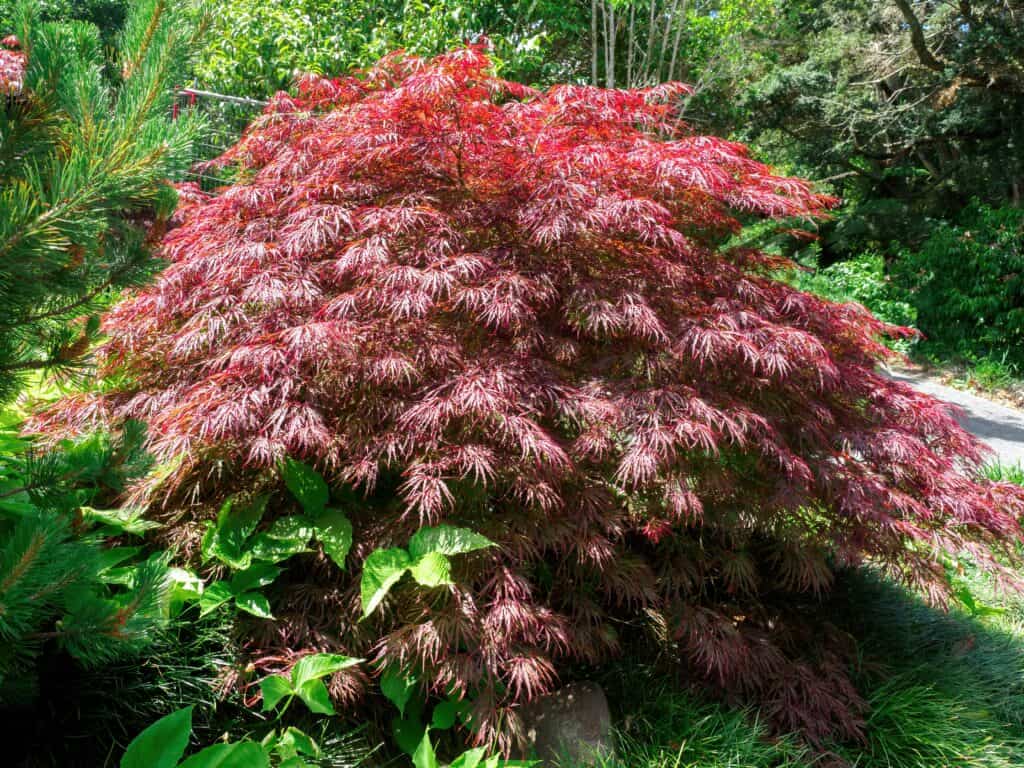
The weeping appearance of Crimson Queen trees makes for dramatic Bonsai tree landscapes!
©Emagnetic/Shutterstock.com
Crimson Queen maple trees are known for their small stature and weeping appearance. In the summer, the leaves of these trees are a dark red color. In the autumn months, this color lightens to a vivid crimson. Other fall colors include bronze, yellow, and purple.
Crimson Queen maple trees thrive best beneath full to partial sun. In cooler areas, more sunlight can contribute to foliage colors that are brighter and more vivid. These trees also need well-draining soil to grow their best.
Red Dragon
Red Dragon maple trees are red throughout most of the year. In the spring and summer, the leaves on these trees are often shades of red and purple. In the autumn, these colors brighten into vivid red.
Because of their small size, Red Dragon maple trees are ideal for containers. This makes them suited for Bonsai tree art! These trees need full to partial sunlight to grow their best. They need moist, well-draining soil, too.
Full Moon
The foliage of the Full Moon Japanese maple trees starts out golden with a green tinge to them. By the autumn months, these yellow leaves have turned orange and red. When planted naturally, these trees can be shaped and grown as a single trunk, even though they are normally shrub-like. This makes the full moon Japanese maple tree suited to Bonsai tree art!
Full Moon Japanese maple trees prefer full sun though they can thrive similarly in partial sun. They need moist, well-draining soil to grow their best, too.
Butterfly
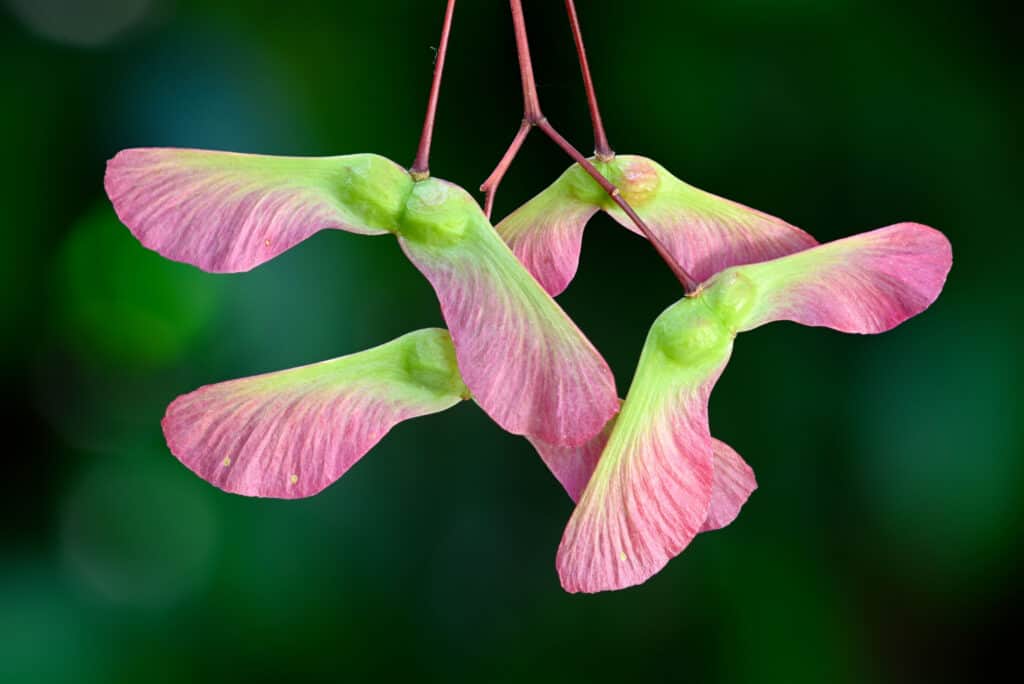
The leaves on these maple trees have tinges of silver, white, and even pink amidst their normal green spring shades.
©AlessandroZocc/Shutterstock.com
Every tree on this list is beautiful in its own way, but the Butterfly Japanese maple tree is especially lovely! The leaves on these trees have tinges of silver, white, and even pink amidst their normal green spring shades. In the fall months, these light-colored parts turn vivid shades of red and purple!
Butterfly Japanese maple trees prefer partial shade, though they can grow under full sun. They love moist, well-draining soil that is slightly acidic.
First Ghost
First Ghost Japanese maple trees are also particularly lovely and unique, due to their colors! In the spring, the leaves on these trees are mostly white or cream-colored. Through the center of these leaves run deep green veins. The edges of these leaves are a vivid red or purple color!
First Ghost Japanese maple trees thrive best in full or partial sun.
Geisha Gone Wild
Geisha Gone Wild maple trees are also considered unique because of their colors! In the spring, the new leaves that sprout are a hot pink color. During the summer they dull to a green color flecked with white, cream, and pink! In the autumn, these leaves turn a vivid orange!
Geisha Gone Wild maple trees thrive best in full or partial sun. They need moist, well-draining soil to grow their best!
Koto Ito Komachi
Koto Ito Komachi maple trees have the appearance of a weeping tree because of their long, thin, draping leaves. These slow-growing trees only reach up to 4 to 6 feet when planted naturally, which makes them perfect for Bonsai tree art. The leaves on Koto Ito Komachi trees start out light green in the spring, turning darker and more vivid in the summer. Come fall, these leaves are turning orange and yellow!
Because the leaves on Koto Ito Komachi trees are delicate, these trees do best in partial shade.
Caring for Your Japanese Maple Bonsai Tree
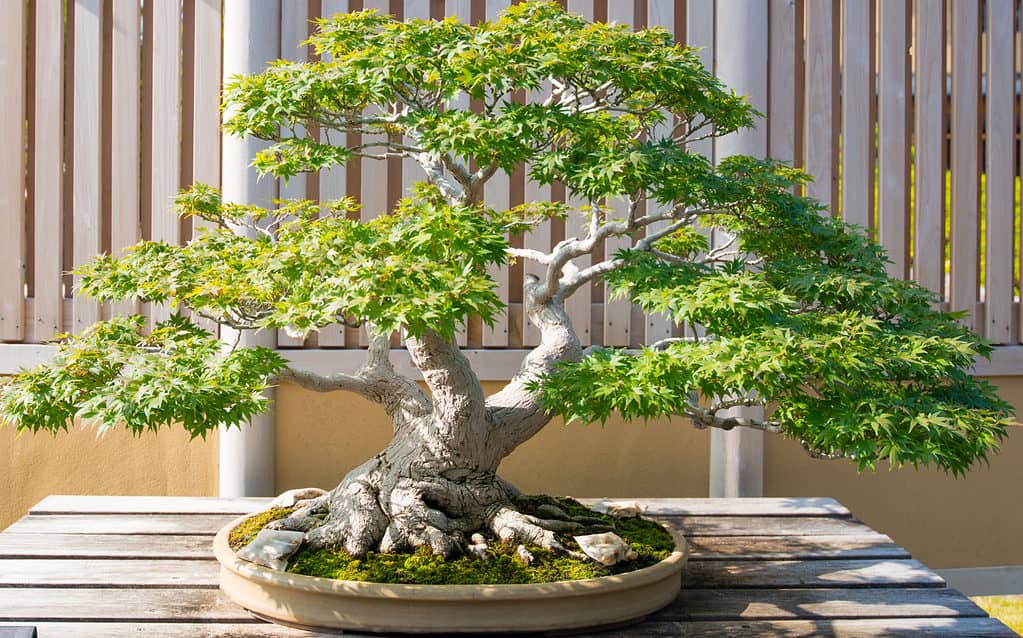
Japanese maple Bonsai trees are worth the time and effort it can take to grow and style!
©khuntapol/Shutterstock.com
While Japanese maple Bonsai trees can be a bit maintenance-heavy, this work pays off when these trees really begin to grow. From sunlight and water to soil and placement, pruning, and ideal Bonsai styles for these trees, we’ve compiled everything you need to know about caring for a Japanese maple Bonsai tree!
Here are some tips on how to help your Japanese maple Bonsai tree grow its best!
Sunlight
As we have seen, most Japanese maple trees like or need a lot of sun. Some of them, like the Koto Ito Komachi or Geisha Gone Wild varieties, do best in partial shade. In warm areas, where summer temperatures regularly reach 85F or above, it is a good idea to keep your Japanese maple Bonsai tree away from direct sunlight!
Soil Type
Most Japanese maple Bonsai trees can thrive in different soil conditions, but they all need moist, well-draining soil. Specialty soil mixes made for Bonsai trees have been designed to be well-draining! Most of these specialty mixes should suit your Japanese maple Bonsai tree well!
Water
During the growing season, it is important to water your Japanese maple Bonsai tree every day. Sometimes when temperatures are hot during this time, you might have to water your tree more than once a day. Keep the soil moist and make sure it does not dry out completely! As a whole, Japanese maple trees prefer water that is either neutral or slightly acidic, whether they are being grown as Bonsai trees or not.
Placement
Since Japanese maple trees generally love sunshine, it is a good idea to place your Japanese maple Bonsai tree where it can soak up as much sun as it can. Some varieties of Japanese maple trees prefer shade to sun, however. In the summer, or when temperatures are hot, try to keep your Japanese maple Bonsai tree out of direct sunlight to protect its leaves.
When temperatures reach 15F or lower, it is a good idea to protect your Japanese maple Bonsai tree. They are known for being frost-hardy, but they do not do very well in freezing temperatures. You can keep them in a cold-frame greenhouse for the season, to protect them!
Pruning Your Japanese Maple Bonsai Tree
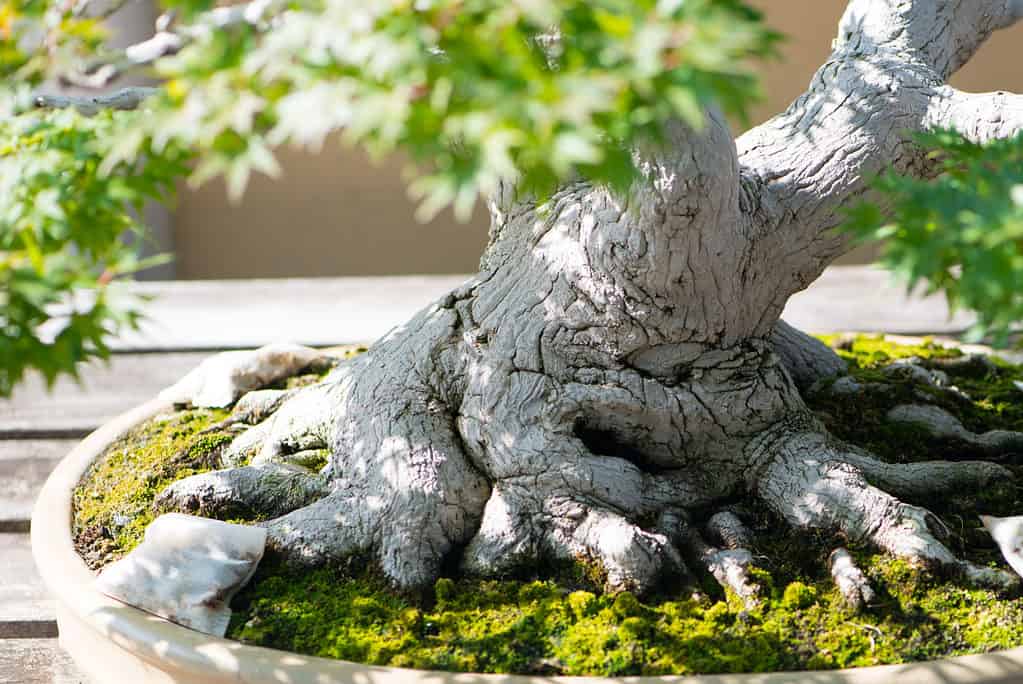
Oftentimes, pruning a Japanese maple Bonsai tree requires focus on the branches, stems, trunk, and leaves.
©khuntapol/Shutterstock.com
Pruning a Japanese maple Bonsai tree can take a lot of effort, patience, and knowledge. Not only do you have to focus on trimming branches and stems, but sometimes the leaves need pruning to ensure proper or aesthetic growth.
You can prune shoots throughout the year. Trimming all but one or two pairs of leaves from these growths is suggested. Be careful when pruning strong or thick trunks, shoots, and stems; this should be done in the summer or fall to counter bleeding.
You can also completely prune Japanese maple Bonsai trees of their leaves during the growing season. This is done, usually, to promote a second growth. This second growth is usually finer and more delicate than the first. To achieve this, you’ll want to leave the stems of the leaves intact when you prune. Doing a full leaf pruning can be stressful for the tree, however. You can, instead, do a partial prune. For a partial prune, simply remove leaves you don’t want on the tree.
Ideal Japanese Maple Bonsai Tree Styles
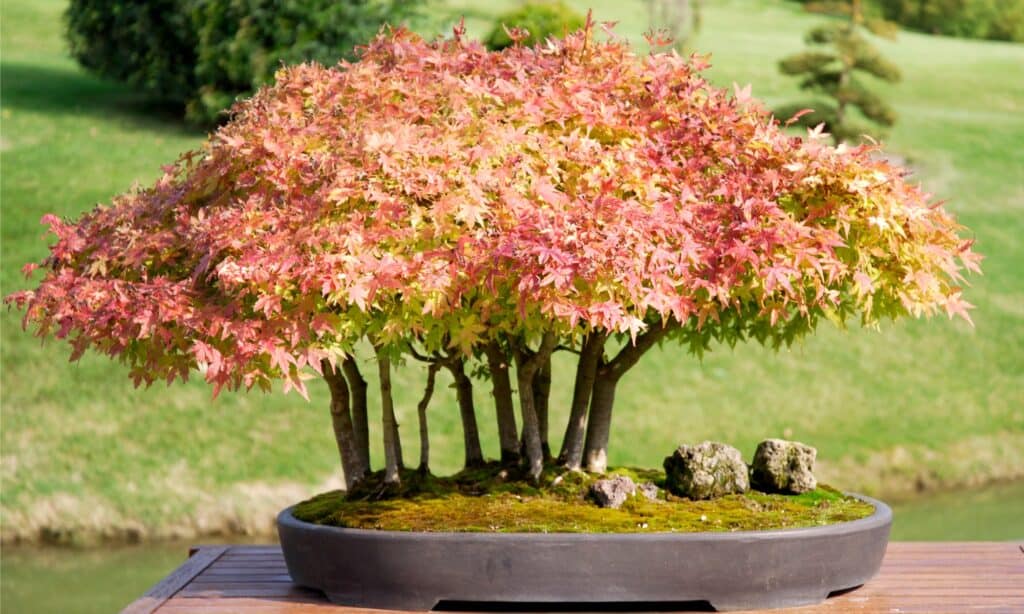
Another popular style for Japanese maple trees is the forest style, known by the Japanese name of Yose-ue.
©iStock.com/Musat
Japanese maple trees work well as Bonsai trees because you can style them in many different ways, ranging from easy to difficult!
One of the most popular styles for Japanese maple Bonsai trees is the Chokkan style. This is also known as the formal upright style, and it involves shaping your Bonsai tree into a single, strong trunk. Similarly, another popular style for these trees is the Sokan style. This style is a bit harder to achieve than Chokkan, as it involves splitting your Bonsai tree into two trunks. But once achieved, it makes for a beautiful, majestic tree!
Another step up is the Kabudachi style, which involves multiple, often small, trunks. Because several types of Japanese maple trees have many smaller, intricate branches, they suit the Kabudachi style well!
The Moyogi Bonsai tree style can be achieved with Japanese maple trees. This is known as the informal upright style and involves curving the trunk of the tree. Another popular style for Japanese maple Bonsai trees is the forest style, known by the Japanese name of Yose-ue.
Propagating Your Japanese Maple Bonsai Tree
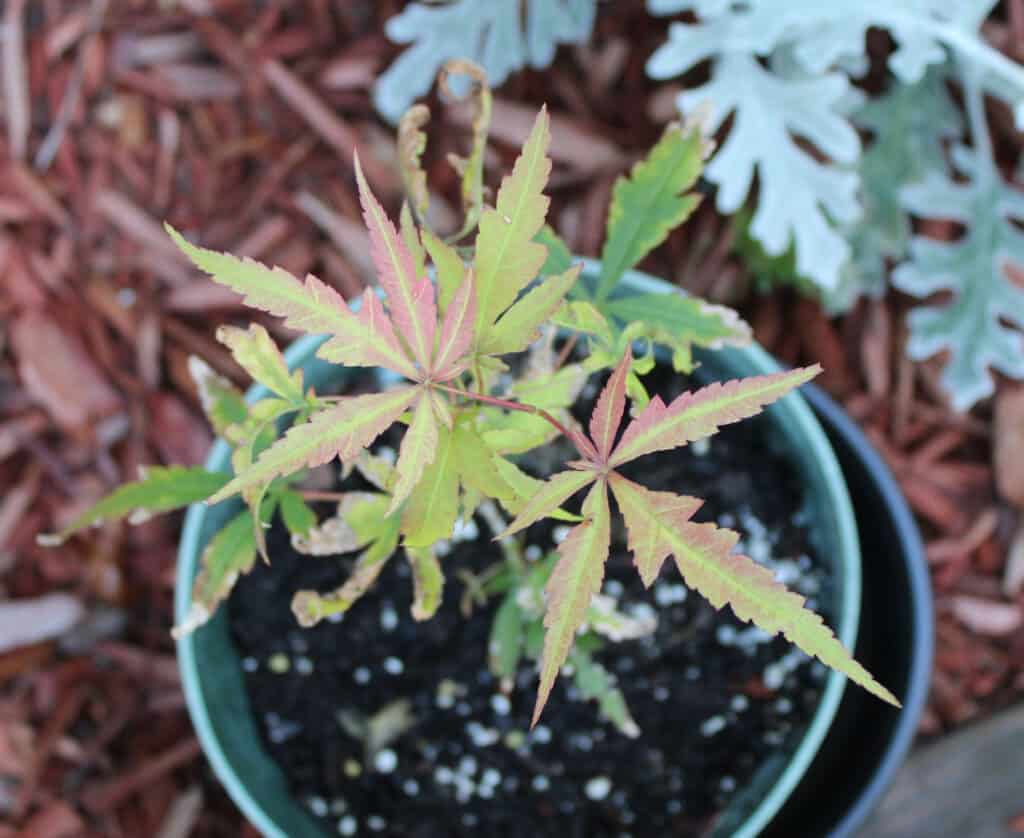
Japanese maple saplings need plenty of water.
©Roca Mharas/Shutterstock.com
Most Japanese maple trees can be easily propagated! You can propagate these trees from cuttings as well as seeds.
Common Problems with Japanese Maple Bonsai Trees
As a whole, Japanese maple trees are known for being rather hardy and sturdy. They can still be susceptible to aphids, but these pests can be easily taken care of with insecticides.
However, despite being so sturdy, there is one disease that can decimate Japanese maple trees. The fungal disease known as Verticillium wilt can kill a Japanese maple tree, either wholly or partly. Unfortunately, it cannot be treated and it also spreads easily between trees. The presence of Verticillium wilt is easy to find in new cuts in the wood; if you spot black spots in these cuts, that is Verticillium wilt. To try and keep it from spreading to other trees, you can clean your tools as carefully as possible.
The photo featured at the top of this post is © meunierd/Shutterstock.com
Thank you for reading! Have some feedback for us? Contact the AZ Animals editorial team.



